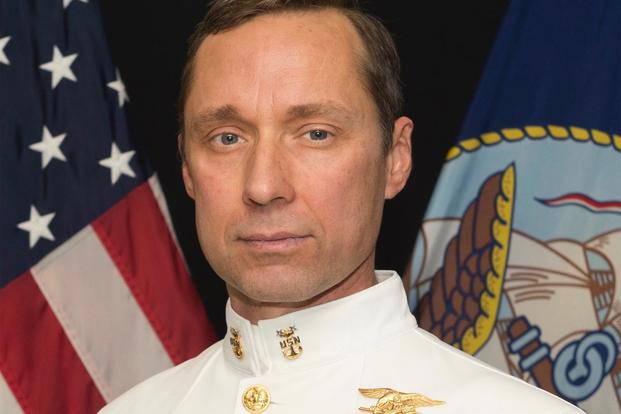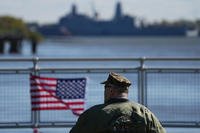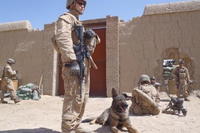A Navy SEAL who led a risky assault on a mountain peak to rescue a stranded teammate in Afghanistan in 2002 will receive the Medal of Honor later this month, according to a White House announcement.
Retired Master Chief Special Warfare Operator Britt K. Slabinski will receive the military's highest honor May 24, according to the announcement.
According to the White House release, Slabinski is credited with leading a team back to rescue another SEAL, Petty Officer 1st Class Neil Roberts, after he was ejected from an MH-47 Chinook crippled by enemy rocket-propelled grenade fire March 4, 2002 in eastern Afghanistan.
The operation would ultimately be known as "The Battle of Roberts Ridge" in honor of Roberts. The team had originally begun the mission the day before, tasked with establishing an outpost on the top of Takur Ghar mountain as part of Operation Anaconda in Afghanistan's Shah-i-Kot Valley.
"Then-Senior Chief Slabinski boldly rallied his remaining team and organized supporting assets for a daring assault back to the mountain peak in an attempt to rescue their stranded teammate," the White House announcement reads. "Later, after a second enemy-opposed insertion, then-Senior Chief Slabinski led his six-man joint team up a snow-covered hill, in a frontal assault against two bunkers under withering enemy fire from three directions."
Slabinski "repeatedly exposed himself to enemy fire" as he took on al-Qaida forces in the rescue attempt, according to the release.
"Proximity made air support impossible, and after several teammates became casualties, the situation became untenable," the release said.
Moving his team into a safer position, Slabinski directed air strikes through the night and, as daylight approached, led "an arduous trek" through waist-deep snow while still under fire from the enemy. He treated casualties and continued to call in fire on the enemy for 14 hours until an extract finally came.
Slabinski previously received the Navy Cross for leading the rescue and directing continued fire on the enemy throughout the lengthy and brutal fight.
"During this entire sustained engagement, Senior Chief Petty Officer Slabinski exhibited classic grace under fire in steadfastly leading the intrepid rescue operation, saving the lives of his wounded men and setting the conditions for the ultimate vanquishing of the enemy and the seizing of Takur Ghar," his medal citation reads. "By his heroic display of decisive and tenacious leadership, unyielding courage in the face of constant enemy fire, and utmost devotion to duty, Senior Chief Petty Officer Slabinski reflected great credit upon himself and upheld the highest traditions of the United States Naval Service."
Slabinski's actions were highlighted in a moving 2016 New York Times account that emphasized the role of Air Force Tech Sgt. John Chapman, who was attached to the SEAL team and ultimately died on the mountain.
Task and Purpose reported in late April that Chapman, credited with saving the entire SEAL team he was attached to during the operation, will posthumously receive the Medal of Honor. The White House has not confirmed that.
Chapman reportedly directed air strikes from AC-130 gunships after Roberts was ejected from the MH-47. During follow-on attempts to rescue Roberts, Chapman would ultimately be wounded by enemy fire from close range.
Reporting surrounding the role of Slabinski and the SEALs in recovering Chapman paints a complex picture. According to the New York Times report, Slabinski believed, and told his men, that Chapman was dead. Air Force officials, however, reportedly contest that Chapman was still alive and fought by himself for more than an hour after the SEALs moved back to a safer position. Predator drone footage reportedly supports this belief.
Slabinski himself told the publication doubt persisted in his mind.
"I'm trying to direct what everybody's got going on, trying to see what's going on with John; I'm already 95 percent certain in my mind that he's been killed," he said in an interview with the Times. "That's why I was like, 'O.K., we've got to move.'"
Slabinski would be just the second living SEAL to receive the Medal of Honor for heroism in Afghanistan. The first, Senior Chief Special Warfare Operator Edward Byers, received the award in February 2016 for his role in rescuing an American doctor who had been captured by the Taliban.
Slabinski will also be the 12th living service member overall to receive the Medal of Honor for actions in Afghanistan.
According to a biography provided by the White House, Slabinski enlisted in the Navy in 1988 and graduated Basic Underwater Demolition/SEAL training in 1990. He completed nine overseas deployments and 15 combat deployments over the course of his career, including multiple tours in Iraq and Afghanistan. He retired as director of the Naval Special Warfare Safety Assurance and Analysis Program after more than 25 years of service, according to releases.
In addition to the Navy Cross, Slabinski's previous awards include the Navy and Marine Corps Medal, five Bronze Stars with combat "V" device, and two Combat Action Ribbons.
Editor's Note: This first paragraph of this story has been corrected to show Slabinski will receive the Medal of Honor later this month.
-- Hope Hodge Seck can be reached at hope.seck@military.com. Follow her on Twitter at @HopeSeck.














